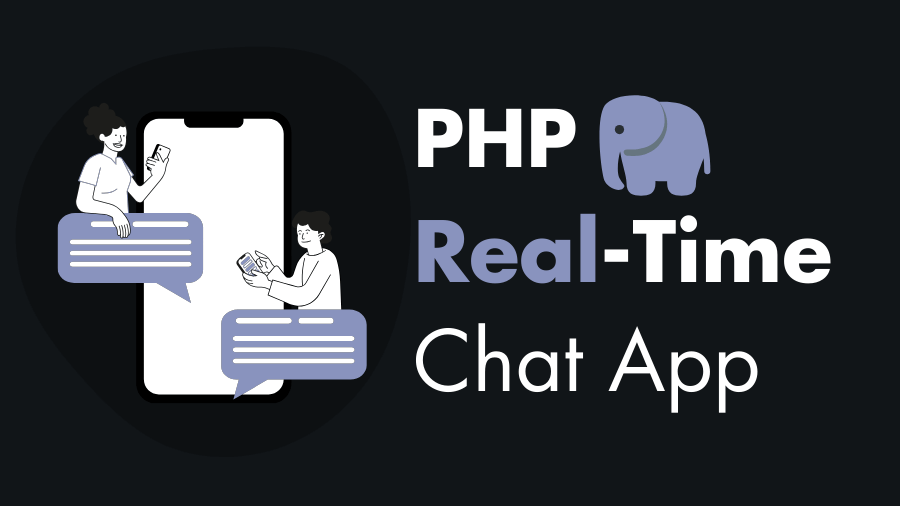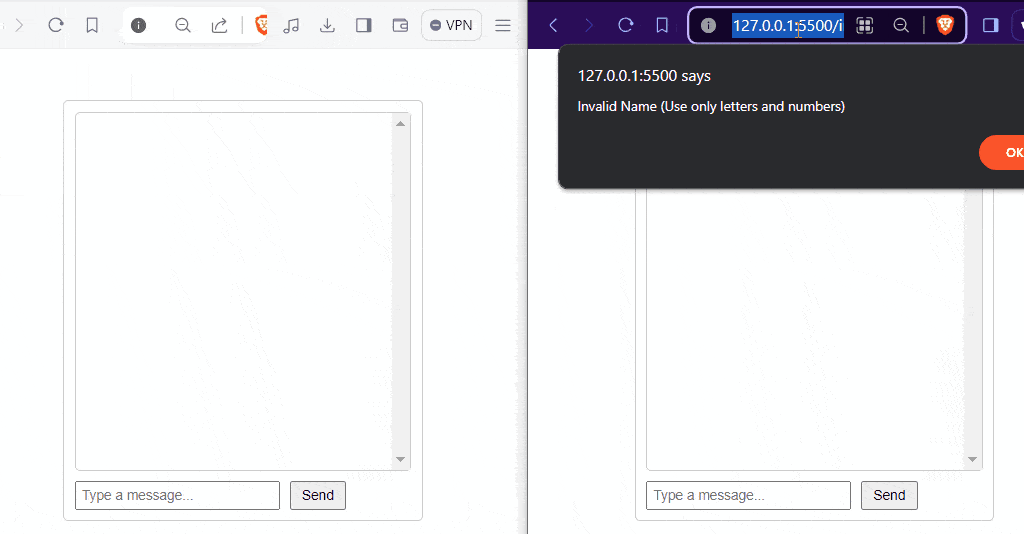
Building a Real-Time Chat Application with PHP and WebSockets
In this tutorial, you’ll learn how to build a real-time chat application using PHP for the backend, WebSockets for real-time communication, and HTML, CSS, and JavaScript for the frontend.
By the end of this guide, you’ll understand how to implement a basic real-time chat app from scratch.
Prerequisites
Before you start, ensure you have the following:
- Basic knowledge of PHP, HTML, CSS, and JavaScript.
- Composer installed to manage PHP dependencies.
- Familiarity with WebSockets and how to use them in PHP.
Technologies Used
- PHP: Backend logic and WebSocket server.
- WebSockets: Real-time, bidirectional communication.
- HTML: Structure of the chat interface.
- CSS: Styling for the frontend.
- JavaScript: WebSocket communication and UI interaction.
Steps to Build the Real-Time Chat Application
- Set Up the Project Folder
- Implement the WebSocket Server
- Create the Frontend UI
- Test the Application
Step 1: Set Up the Project Folder
Create a new project folder called php-chat-app. Inside this folder, install the Ratchet library for WebSockets using Composer.
composer require cboden/ratchetYour folder structure will look like this:
php-chat-app/
│
├── vendor/ # Composer dependencies (created when you run `composer install`)
├── socket.php # WebSocket server (PHP)
├── index.html # Frontend HTML layout
├── script.js # JavaScript for WebSocket interaction
└── styles.css # CSS for styling the chat UI
├── composer.json # Composer configuration file (auto-generated)
└── composer.lock # Lock file for Composer dependenciesStep 2: Implement the WebSocket Server
Next, create the WebSocket server using the Ratchet library. Create a file named socket.php and use the following code to set up the server:
<?php
use Ratchet\MessageComponentInterface;
use Ratchet\ConnectionInterface;
require __DIR__ . '/vendor/autoload.php';
class MyChat implements MessageComponentInterface {
protected $clients;
public function __construct() {
$this->clients = new \SplObjectStorage;
}
public function onOpen(ConnectionInterface $conn) {
$this->clients->attach($conn);
}
public function onMessage(ConnectionInterface $from, $msg) {
foreach ($this->clients as $client) {
if ($from !== $client) {
$client->send($msg);
}
}
}
public function onClose(ConnectionInterface $conn) {
$this->clients->detach($conn);
}
public function onError(ConnectionInterface $conn, \Exception $e) {
$conn->close();
}
}
$app = new Ratchet\App('localhost', 8080);
$app->route('/chat', new MyChat, array('*'));
$app->run();This script creates a WebSocket server that listens for incoming connections, handles messages, and broadcasts them to all connected clients except the sender.
Step 3: Create the Frontend UI
Create the frontend chat interface in index.html:
<!DOCTYPE html>
<html lang="en">
<head>
<meta charset="UTF-8" />
<meta name="viewport" content="width=device-width, initial-scale=1.0" />
<title>PHP Realtime Chat Application</title>
<link rel="stylesheet" href="./styles.css" />
</head>
<body>
<div class="chat-container">
<div class="chat-box" id="chat-box"></div>
<input
type="text"
id="user-input"
placeholder="Type a message..."
onkeydown="submitOnEnter(this)"
/>
<button onclick="sendMessage()">Send</button>
</div>
<script src="./script.js"></script>
</body>
</html>Now, style the chat interface using the following styles.css:
* {
box-sizing: border-box;
scroll-behavior: smooth;
}
body {
font-family: Arial, sans-serif;
}
.chat-container {
width: 350px;
margin: 50px auto;
border: 1px solid #ccc;
border-radius: 5px;
padding: 10px;
}
.chat-box {
height: 350px;
overflow-y: scroll;
margin-bottom: 10px;
padding: 10px;
border: 1px solid #ccc;
border-radius: 5px;
}
input[type="text"] {
width: 200px;
padding: 5px;
margin-right: 5px;
}
button {
padding: 5px 10px;
cursor: pointer;
}
.incoming,
.outgoing {
display: flex;
}
.outgoing {
justify-content: flex-end;
}
.incoming {
justify-content: flex-start;
}
.wrapper .name,
.wrapper .message {
margin: 0;
padding: 0;
font-size: 14px;
}
.wrapper .name {
font-size: 12px;
}
.wrapper .message {
background: #fbf3d4;
border: 1px solid rgba(0, 0, 0, 0.1);
border-radius: 3px;
padding: 3px;
}
.incoming .message {
background: #ec1982;
color: white;
}Step 4: Write JavaScript for WebSocket Interaction
Now, create the script.js to handle WebSocket communication and message sending/receiving:
var socket = new WebSocket("ws://localhost:8080/chat");
let userName = null;
let socketIsOn = false;
const userInput = document.querySelector("#user-input");
const chatBox = document.querySelector("#chat-box");
socket.onopen = function () {
socketIsOn = true;
};
(function () {
const name = localStorage.getItem("name");
if (name) {
userName = name;
return;
}
let person = prompt("Please enter your name:");
if (person && /^[A-Za-z0-9 ]+$/.test(person)) {
localStorage.setItem("name", person);
userName = person;
} else {
alert("Invalid Name. Use only letters and numbers.");
handleUserName();
}
})();
function createEl(type, attr = {}) {
const el = document.createElement(type);
for (let i in attr) {
el.setAttribute(i, attr[i]);
}
return el;
}
function generateMessage(userName, msg) {
const wrapper = createEl("div", { class: "wrapper" });
const name = createEl("span", { class: "name" });
name.innerText = userName;
const message = createEl("p", { class: "message" });
message.innerText = msg;
wrapper.appendChild(name);
wrapper.appendChild(message);
return wrapper;
}
function sendMessage() {
const message = userInput.value.trim();
if (userName && socketIsOn && message) {
const msg = generateMessage(userName, message);
const outgoingMsg = createEl("div", { class: "outgoing" });
outgoingMsg.appendChild(msg);
chatBox.appendChild(outgoingMsg);
socket.send(JSON.stringify({ name: userName, message }));
userInput.value = "";
}
}
socket.onmessage = function ({ data }) {
const { name, message } = JSON.parse(data);
const msg = generateMessage(name, message);
const incomingMsg = createEl("div", { class: "incoming" });
incomingMsg.appendChild(msg);
chatBox.appendChild(incomingMsg);
};
function submitOnEnter(ele) {
if (event.key === "Enter") {
sendMessage();
}
}Step 5: Test the Application
To test the application:
-
Start the WebSocket server:
php socket.php -
Open
index.htmlin two different browser windows (use incognito mode for separate sessions). -
You should now be able to send and receive messages in real time between the two browser windows.

Conclusion
Congratulations! You’ve built a simple real-time chat application using PHP and WebSockets. You can further enhance this app by adding features like user authentication, message persistence, and multimedia support.
Happy coding!